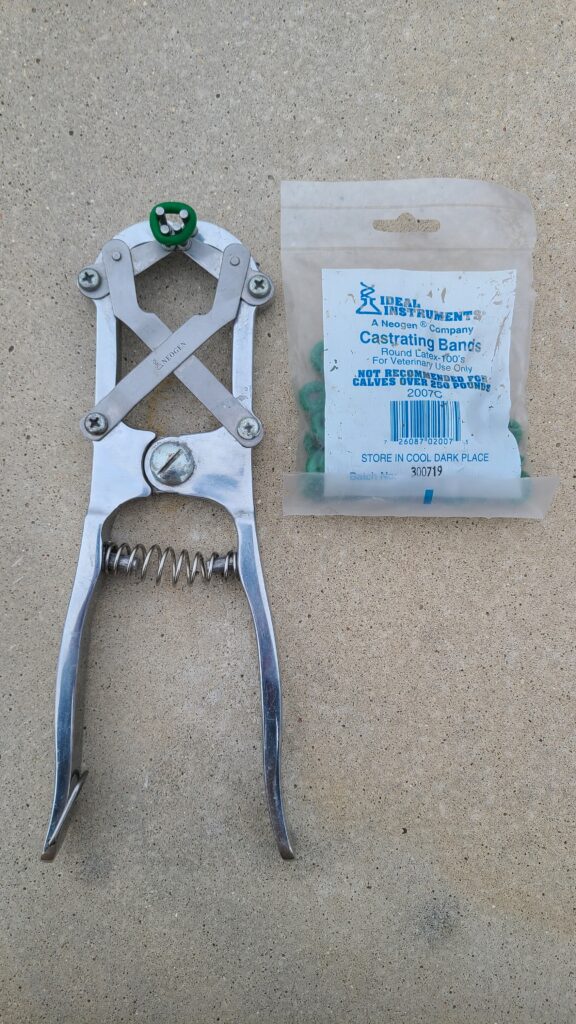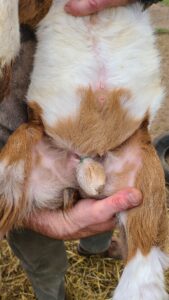Banding is an effective method of castration for male goat kids. Learn how to use an elastration tool for banding goats. Provided are the equipment and steps needed to complete this procedure on your own farm.

This post contains affiliate links. As an Amazon Associate, I earn from qualifying purchases.
I am pretty selective when it comes to allowing a buck kid on my farm to stay a buck kid. By far, most of my male goat offspring each year are wethered and become happy, healthy market animals or pets.
The castration method I currently utilize, and have been utilizing for decades with much success, is castration via elastrator.
How does an elastrator work?
Using an elastration tool, a small elastic band is secured at the top of the scrotum, near the body. This band cuts off blood flow to the testes, causing them to atrophy. The scrotum then shrivels up and eventually falls off. The result is the sterilization of the male animal.
Other Methods of Castration
There are other methods of castration to consider, including cutting and crushing of the scrotum. I prefer elastration because there is less risk of infection than cutting, as there is not an open wound to deal with. Crushing with a Burdizzo is an effective method, but its success is largely impacted by the skill level of the person performing the procedure. Another potential issue with crushing is that without a thorough assessment, the residual scrotal tissue can be confused with the animal still being intact.
My recommendation is to find a mentor to observe and help train you on your preferred method of castration or, for peace of mind, have the procedure performed by a licensed veterinarian.
Regardless of the castration method chosen, the buckling should be vaccinated prior for tetanus. For more information on the CD+T vaccine, click here to read my article.
When to Band Buck Kids
There are different schools of thought on the best time to band buck kids. Issues ranging from impact on growth and development, possibility of developing urinary calculi later in life, and pain induced by the procedure impact the decision on when to band. On our farm, we choose to band kids when they are between 6 and 10 weeks of age.
Materials Needed for Banding a Buck Kid
The elastrator tool should be easy to open and close with one hand. I have used ones that are part plastic and part metal, but prefer the sturdiness of the all-aluminum one that I have currently. Traditional castration bands are made of latex and are green in color. You can obtain castration bands that slowly release lidocaine, a pain medication, over time from your veterinarian to make the process more comfortable for the animal.
Directions for Banding a Buck Kid

- 1. Load the castration band onto the prongs of the elastrator tool
- 2. Secure the buck kid, an extra set of hands is helpful
- 3. Ensure that both testicles have descended into the scrotum, if only one can be palpated, stop and do not band the buckling
- 4. Squeeze the elastrator to stretch out the band
- 5. Place the scrotum through the stretched band, ensure that both testes are below the band and that it is close to the body before letting the band contract
- 6. Gently release the elastrator tool, making sure the scrotum with both testes are enclosed, but not any teats or extra skin
- 7. Remove the elastrator tool and examine your work
- 8. Observe the buckling closely for the first 24 hours. It is normal for them to walk a little stiffly the first few steps or to lie down, but they usually get right back to their normal eating, drinking, and playing
- 9. In a few weeks, make sure the scrotum has fallen off and that the site is healed

Mother, farmer, author, and teacher by trade… She loves tending to things and watching them grow!
